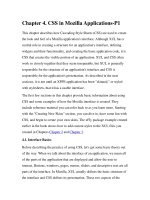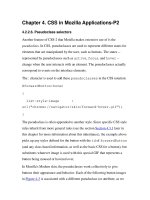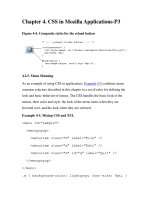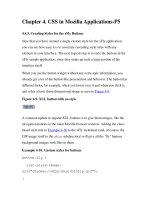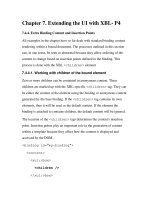Pro Business Applications with Silverlight 4 pptx
Bạn đang xem bản rút gọn của tài liệu. Xem và tải ngay bản đầy đủ của tài liệu tại đây (8.8 MB, 578 trang )
THE EXPERT’S VOICE
®
IN SILVERLIGHT
Pro
Business Applications
with Silverlight 4
Chris Anderson
Create rich business applications customized
to your needs quickly and efficiently
www.it-ebooks.info
www.it-ebooks.info
Pro Business Applications
with Silverlight 4
Chris Anderson
www.it-ebooks.info
Pro Business Applications with Silverlight 4
Copyright © 2010 by Chris Anderson
All rights reserved. No part of this work may be reproduced or transmitted in any form or by any
means, electronic or mechanical, including photocopying, recording, or by any information storage or
retrieval system, without the prior written permission of the copyright owner and the publisher.
ISBN-13 (pbk): 978-1-4302-7207-6
ISBN-13 (electronic): 978-1-4302-7206-9
Printed and bound in the United States of America 9 8 7 6 5 4 3 2 1
Trademarked names may appear in this book. Rather than use a trademark symbol with every
occurrence of a trademarked name, we use the names only in an editorial fashion and to the benefit of
the trademark owner, with no intention of infringement of the trademark.
President and Publisher: Paul Manning
Lead Editor: Jon Hassell
Technical Reviewer:
Editorial Board: Clay Andres, Steve Anglin, Mark Beckner, Ewan Buckingham, Gary Cornell,
Jonathan Gennick, Jonathan Hassell, Michelle Lowman, Matthew Moodie, Duncan Parkes,
Jeffrey Pepper, Frank Pohlmann, Douglas Pundick, Ben Renow-Clarke, Dominic Shakeshaft,
Matt Wade, Tom Welsh
Coordinating Editor: Tracy Brown
Copy Editors: Julie Hammond, Damon Larson, Heather Lang, Kim Wimpsett.
Compositor: Bytheway Publishing Services
Indexer: Toma Mulligan
Artist: April Milne
Cover Designer: Anna Ishchenko
Distributed to the book trade worldwide by Springer-Verlag New York, Inc., 233 Spring Street, 6th
Floor, New York, NY 10013. Phone 1-800-SPRINGER, fax 201-348-4505, e-mail
orders-ny@springer-
sbm.com, or visit www.springeronline.com.
For information on translations, please e-mail
, or visit www.apress.com.
Apress and friends of ED books may be purchased in bulk for academic, corporate, or promotional
use. eBook versions and licenses are also available for most titles. For more information, reference our
Special Bulk Sales–eBook Licensing web page at
www.apress.com/info/bulksales.
The information in this book is distributed on an “as is” basis, without warranty. Although every
precaution has been taken in the preparation of this work, neither the author(s) nor Apress shall have
any liability to any person or entity with respect to any loss or damage caused or alleged to be caused
directly or indirectly by the information contained in this work.
The source code for this book is available to readers at
www.apress.com. You will need to answer
questions pertaining to this book in order to successfully download the code.
www.it-ebooks.info
For my grandmother Connie, a great role model for will power, optimism,
generousity, patience, and love. I miss her dearly.
www.it-ebooks.info
iv
Contents at a Glance
Contents at a Glance iv
Contents v
About the Author xix
Acknowledgments xx
Chapter 1: Introduction 1
Chapter 2: Getting Started with Silverlight 13
Chapter 3: An Introduction to XAML 35
Chapter 4: The Navigation Framework 73
Chapter 5: Exposing Data from the Server: Using WCF RIA Services 93
Chapter 6: Implementing Summary Lists 141
Chapter 7: Building Data Entry Forms 189
Chapter 8: Securing Your Application 245
Chapter 9: Styling Your Application 269
Chapter 10: Advanced XAML and Data Binding 287
Chapter 11: Creating Custom Controls 331
Chapter 12: The Model-View-ViewModel (MVVM) Design Pattern 373
Chapter 13: Printing and Reporting 403
Chapter 14: Out of Browser Mode, and Interacting with the
Operating System 427
Chapter 15: Application Deployment 483
Index 513
www.it-ebooks.info
v
Contents
Contents at a Glance iv
Contents v
About the Author xix
Acknowledgments xx
Chapter 1: Introduction 1
Who This Book Is For 1
About This Book 2
About the Author 3
Silverlight Overview 4
What Is Silverlight? 4
A Short History of Silverlight 6
What Can Silverlight Bring to Your Business Application? 7
When Should You Not Use Silverlight? 8
Comparing Silverlight to Other Microsoft Platforms 9
Comparison with Adobe Flash/Flex 11
Business Applications Overview 11
Summary 12
Chapter 2: Getting Started with Silverlight 13
Required Tools 13
Visual Studio 13
Expression Blend 4 and SketchFlow 14
www.it-ebooks.info
CONTENTS
vi
Silverlight 4 Tools 15
WCF RIA Services 15
Silverlight Toolkit 15
SQL Server 2008 Express Edition 15
Silverlight Spy (and .NET Reflector) 16
Creating a Silverlight Application 16
Silverlight Application 17
Silverlight Navigation Application 18
Silverlight Business Application 18
Silverlight Class Library 18
WCF RIA Services Class Library 19
Silverlight Unit Test Application 19
Running and Exploring the Default Silverlight Business Application Project 19
Exploring the Initial Silverlight Project Structure 22
Project Links 24
The Web Application Project Structure 26
The Silverlight Application Project Structure 28
Recommended Project Template Modifications 31
XAP Files 32
Summary 33
Chapter 3: An Introduction to XAML 35
Overcoming XAML’s Steep Learning Curve 35
Why Learn XAML? 36
XAML Syntax, Document Structure, and Features 37
Core XAML Syntax 37
Creating an Object Hierarchy 38
Namespaces 39
Assigning Property Values to Controls 41
www.it-ebooks.info
CONTENTS
vii
Attached Properties 44
XAML Namespace Properties 45
Design-Time Properties 46
Markup Extensions 47
Namescopes 49
Controls 50
Base Control Classes 51
Layout Controls 53
XAML vs. Windows Forms Controls’ Property Names 57
Assigning Event Handlers 58
Creating a Simple User Interface 60
Resources and Resource Dictionaries 62
Styles 64
Templates 65
Data Binding 65
Binding to an Object 66
Binding to a Collection 69
Designing User Experiences 70
The Designer/Developer Workflow 71
XAML User Interfaces: A Different Perspective 71
Summary 72
Chapter 4: The Navigation Framework 73
Getting Started with the Navigation Framework 73
Components of the Navigation Framework 75
The Frame Control 75
The Page Class 76
The NavigationService Object 76
The NavigationContext Object 77
www.it-ebooks.info
CONTENTS
viii
Navigating Between Views 77
View URIs 77
Navigation Methods on the Frame Control 78
Navigation Methods on the NavigationService Object 78
Using a HyperlinkButton Control 79
Using the Source Property of the Frame Control 79
User-Initiated Navigation 79
Passing Data Between Views 80
Passing Data Using Query String Parameters 80
Reading Query String Parameters 81
Passing Complex Data Types Between Views 82
Deep Links 82
URI Mapping to Enable Friendly URIs 83
Integrating with the Browser History 85
Handling Navigation Events 87
Frame Events 87
View Events 88
Caching Views 89
Visual Transition Effects 90
Alternative User Interface Frameworks 91
Summary 91
Chapter 5: Exposing Data from the Server: Using WCF RIA Services 93
What Is WCF RIA Services? 94
How the WCF RIA Services Code Generator Works 95
How Do You Use WCF RIA Services? 96
Linking Your Silverlight and Web Projects 97
Creating Your Domain Services 97
Creating Domain Operations on Your Domain Services 97
www.it-ebooks.info
CONTENTS
ix
Consuming the Domain Services 98
Getting Started 98
Creating a Data Access Layer Using the Entity Framework 101
Configuring the Database 101
About the Entity Framework 101
Creating an Entity Model 102
Domain Services 102
Understanding the Domain Service Life Cycle 103
Creating a Domain Service 104
Domain Operations 107
Query Operations 107
Insert/Update/Delete Operations 109
Invoke Operations 111
Custom Operations 111
Decorating Entities 112
Metadata Classes 113
Controlling Client Entity Generation 113
Validation 115
Presentation 118
Miscellaneous Data Annotations 118
Presentation Model Types 119
Creating the Presentation Model Class 120
Populating and Exposing Your Presentation Model Types 121
Updating Your Presentation Model Types 122
Sharing Code/Logic Across Tiers 123
Inspecting the Generated Code in the Silverlight Project 124
Encapsulating Logic in a Separate WCF RIA Services Class Library 125
Handling Server Errors 126
www.it-ebooks.info
CONTENTS
x
Handling Data Concurrency Violations 127
Methods of Identifying Concurrency Violations . 127
Configuring the Entity Model to Check for Concurrency Violations . 128
Testing Your Solution . 129
Resolving Conflicts in the Domain Service. 130
Transactions 131
WCF RIA Services Toolkit 132
Alternative Communication Technologies 133
WCF Services. 134
WCF Data Services . 137
HTTP Requests . 138
Sockets. 139
Summary 139
Chapter 6: Implementing Summary Lists 141
Exposing a Summary Collection from the Server 142
Collections and Collection Views 144
ObservableCollection<T>. 144
Views. 144
Consuming Data from the Server 146
Understanding the Domain Context. 146
XAML-Based Approach. 146
Code-Based Approach. 148
Choosing the Right Approach . 149
Explicitly Specifying a Domain Service Host . 150
Using the BusyIndicator Control . 150
Displaying the Summary List 152
Retrieving the Data from the Server. 153
Configuring and Customizing a Control for Displaying Data. 153
www.it-ebooks.info
CONTENTS
xi
Choosing the Right Control 164
Manipulating Summary Lists 165
Querying Data Exposed by a Domain Operation 165
Filtering the Summary List 168
Sorting the Summary List 170
Grouping the Summary List 172
Paging the Summary List 175
Drilling Down on a Record 178
Opening Details in a New View 179
Opening Details in a Pop-Up Window 180
Displaying Details Using the DataGrid’s Row Details 183
Implementing a Master/Details View 184
Handling Errors 184
Summary 187
Chapter 7: Building Data Entry Forms 189
Creating the Data Entry User Interface 189
Laying Out the Data Entry Form 189
Refining the Data Entry Form’s Functionality 201
Using the DataGrid for Data Entry 212
Structuring Objects for Use by Data Entry Forms 216
Implementing the INotifyPropertyChanged Interface 216
Implementing the IEditableObject Interface 220
Adding Calculated Properties to Your Classes 222
Data Validation 223
Displaying Validation Errors 223
Types of Data Validation 226
Defining Validation Rules 227
Exposing Validation Errors to the User Interface 228
www.it-ebooks.info
CONTENTS
xii
Notifying the User Interface of Object-Level Validation Errors 234
The Validator Class 235
Customizing Validation Attribute Error Messages 238
Submitting Changes to the Server 238
Change-Tracking 238
Submitting Changes via the DomainDataSource Control 239
Submitting Changes via a Domain Context 239
Handling Errors 240
Handling Concurrency Violations 242
Summary 243
Chapter 8: Securing Your Application 245
Implementing Server-Side Security Using RIA Services 245
The ASP.NET Membership API 246
Configuring Your Database for Forms Authentication 247
Authentication 249
Requiring Authentication 250
Role-Based Operation Access Restrictions 251
Returning a Subset of Data Based on the User’s ID or Role 253
Permitting Update/Delete Operations According to Data 253
Exposing Custom User Profile Data 253
User Registration 254
Avoiding SQL Injection Attacks 255
Sanitizing Errors Sent to the Client 256
Implementing Client-Side Security 256
Authenticating and Registering Users 256
Accessing and Updating User Information 259
Implementing Client-Side Restrictions 260
Storing Data Locally 262
Encrypting Data Passed Between the Server and the Client 262
www.it-ebooks.info
CONTENTS
xiii
Cross-Domain Access Policies 263
Implementing Cross-Domain Policies for HTTP-Based Communication 264
Implementing Cross-Domain Policies for Socket-Based Communication 265
Implementing Cross-Scheme Access Policies 265
Restricting Access to Your Application 266
Summary 268
Chapter 9: Styling Your Application 269
The Designer/Developer Workflow 269
Defining Style Resources 271
Defining a Style Resource 272
Defining Style Resources at Various Locations 273
Naming Style Resources 275
Inheriting Style Resources 276
Styling Constraints 277
Control Templates 277
Default Control Templates 278
Templating a Control 278
Control Template Structure 279
Theming 282
Creating a Custom Theme 282
Silverlight Toolkit Themes 283
Silverlight Navigation/Business Application Themed Project Templates 283
Icons and Images 283
Animation 284
Pixel Shaders / Effects 284
Miscellaneous Styling Tips 285
Defining Constants in XAML 285
Restoring a Control’s Default Style 286
www.it-ebooks.info
CONTENTS
xiv
Summary 286
Chapter 10: Advanced XAML and Data Binding 287
Advanced XAML 287
Comments in XAML 287
Defining Constants 288
Using OR to Combine Enumerated Values in XAML 289
Triggers, Actions, and Behaviors 289
Blendability 299
Creating Consolidated Namespaces 301
MoXAML Power Toys 303
Advanced Data Binding 303
Assigning the Source of a Binding 304
Binding to a Resource 308
Defining Resources in the Code-Behind (For Binding To) 311
Binding to Nested Properties 311
Binding to Indexed Properties 312
Binding to Collection Views 312
Enhancing Data Binding 317
Data Binding in Code 323
Getting and Setting Attached Property Values in Code 324
Additional Tips 324
Summary 329
Chapter 11: Creating Custom Controls 331
Adding Functionality to an Existing Control 331
Creating User Controls 332
Creating a Simple User Control 332
Exposing Properties 333
Exposing Methods 345
www.it-ebooks.info
CONTENTS
xv
Exposing Events 346
Determining If in Design-Time or Runtime Mode 347
Constraining the User Control’s Size 347
Creating Custom Controls 347
Creating the Custom Control 348
The Control Structure 349
Defining the Control’s Default Template 350
Defining the Control’s Behavior 359
Content Controls 365
Containing a Single Control as Content 365
Containing Multiple Controls as Content 367
Attached Properties 369
Summary 370
Chapter 12: The Model-View-ViewModel (MVVM) Design Pattern 373
The Purpose of Implementing MVVM 374
Why You Should Implement MVVM 375
MVVM Theory 376
The Layers 376
View / View Model Configurations 379
MVVM in Practice 380
Creating the Layers 380
Connecting the Layers 383
View and ViewModel Interactions 385
Layer Interaction Summary 392
Hotly Debated Implementation Details 393
MVVM and RIA Services 395
Implementing the Model 395
Implementing the View Model 396
www.it-ebooks.info
CONTENTS
xvi
Implementing the View 399
Frameworks 401
Summary 401
Chapter 13: Printing and Reporting 403
The Importance of Implementing Reporting 403
Potential Solutions for Implementing Reporting 404
Generating a PDF 404
Generating HTML 405
Generating Office Documents 405
Using Silverlight 4 Printing Functionality 405
Third-Party Report Viewers 405
Office Integration Using COM 407
Choosing a Reporting Strategy 407
Printing Functionality in Silverlight 407
Generating and Displaying a PDF Report 409
Generating a Report on the Server 409
Displaying the Report on the Client 418
Summary 426
Chapter 14: Out of Browser Mode, and Interacting with the
Operating System 427
Out of Browser 427
Configuring OOB Mode 428
Installing the Application to Run Out of Browser 429
Determining Installation Status 431
Determining Whether Running Inside or Outside the Browser 432
Where/How is the Application’s .xap File Stored and Run? 432
Interacting with the OOB Window 433
Checking for Updates 434
www.it-ebooks.info
CONTENTS
xvii
Debugging Out of Browser 436
Uninstalling the Application 436
Toast Notifications 437
Caching Data Locally 439
Caching to Isolated Storage 439
Caching to a Client-Side Database 449
Detecting Network Connection Availability 451
File System Open/Save Dialogs 451
The Open File Dialog 452
The Save File Dialog 456
Drag Drop Target 459
Clipboard 460
Full Screen 462
Initiating Full Screen Mode 462
Detecting the Switch to and from Full Screen Mode 463
Retaining Full Screen Mode When Unfocused 463
Keyboard Access 464
Elevated Trust 464
Enabling Elevated Trust 465
File System Access 466
COM Automation 471
Custom Chrome 478
Other Restrictions Lifted By Elevated Trust 480
Restrictions Imposed by Elevated Trust 481
Disabling Elevated Trust Applications with a Windows Group Policy 481
Summary 482
Chapter 15: Application Deployment 483
Deploying the Application to the Server 483
www.it-ebooks.info
CONTENTS
xviii
Server Requirements 484
Using Xcopy 485
Publishing 486
Creating a Web Package 487
Creating a Setup Program 488
Deploying the Application to the Client 488
The Default Silverlight Installation Process 489
Customizing the Silverlight Installation Experience 490
Pushing the Silverlight Runtime to Users in the Enterprise 493
Building a Client Desktop Installer 494
Improving on the Default Application Loading Screen 495
Creating the Application Pre-loader Files 496
Designing the Application Pre-loader 497
Updating the Application Download Progress 499
Configuring the Application Pre-loader in the HTML File 500
Testing the Application Pre-loader 500
Partitioning Your Application 502
Initial Steps 502
Assembly Caching 502
Downloading Modules on Demand 505
Digitally Signing Your Application 506
Summary 511
Index 513
www.it-ebooks.info
xix
About the Author
Chris Anderson has been a professional developer for over 10 years, specializing in building desktop,
web, and mobile business applications using Microsoft technologies for industries as wide ranging as
accounting, property valuation, mining, the fresh produce industry, logistics, field services, sales, and
construction. He holds a Bachelor of Engineering in Computer Systems with a Diploma in Engineering
Practice.
Chris is now a co-owner of Peer Placements (a specialist recruitment firm for software developers),
in addition to working as a consultant, author, and Australian representative of the SilverlightShow.net
website. Currently specializing in Silverlight Chris has spoken on this topic at conferences such as Code
Camp Australia, TechEd Australia, Silverlight Code Camp Australia, REMIX Australia, and numerous
Sydney Silverlight Designer and Developer Network (SDDN) meetings (for which he is a co-organizer).
Chris maintains a blog at , and can be found on Twitter at
www.it-ebooks.info
xx
Acknowledgments
I had no idea what I was getting into when taking on this book. Writing a book is a long, arduous task
that consumes your entire life, but now that this book is complete I would like to thank those who were
instrumental in helping it come to fruition.
I’d like to start by thanking the members of the Apress team with whom I worked closely throughout
the writing process. I’m grateful for their guidance and encouragement. I’d like to thank Jonathon
Hassell and Anne Collett, and in particular Tracy Brown, who was extremely patient with me even as
deadlines were rapidly approaching. My great thanks also go to my technical editor Ilia Iordanov, who,
with an eagle eye, spotted many issues I had missed, and made some great suggestions.
I would especially like to thank Greg Harris (www.GregMHarris.com) who gave his time to review every
chapter in its draft form, and who provided me with extensive feedback. I really appreciate the amount
of time and effort Greg voluntarily spent on this project. His contributions are invaluable.
I would also like to thank Miguel Madero and Pencho Popadiyn, who provided additional valuable
feedback on the Model-View-ViewModel Design Pattern chapter, and Sergey Klementiev for providing a
solution to a problem I had with RIA Services. My thanks also go to all the Silverlight bloggers who
provided solutions to difficult problems. I’ve credited you in the text when you’ve provided information
that helped me along my way.
From a personal perspective, I’d really like to thank my sister Michelle, chef extraordinare, for
providing me with home-cooked frozen meals that kept me decently fed for a month when I was
working furiously on this book and barely leaving the house. It was a huge help. I’d also like to thank
Mark Wallis, who covered for me with my clients whilst I had my head down writing. I hope they’ll
forgive my absence.
www.it-ebooks.info
C H A P T E R 1
1
Introduction
Silverlight is a web-based platform from Microsoft that can be used to build rich Internet applications
(RIAs). Of the many new possibilities it enables, one receiving a lot of attention is its huge potential as a
platform for building business applications. Despite its relative youth (having just reached its third
birthday), it has achieved remarkable maturity, with its development progressing at a rapid rate—now at
version 4. With just nine months separating versions 2 and 3, and a further nine months separating
versions 3 and 4, its tremendous growth in that short time demonstrates the enormous amount of effort
and commitment that Microsoft is pouring into Silverlight to bring it to the forefront as one of its core
development platforms. Community support for the technology has been overwhelmingly positive,
gaining more and more momentum as companies increasingly choose it over more mature platforms.
This ensures its future as a viable platform for delivering applications that you can be sure will only grow
and become ever more popular.
If you have previously only been exposed to Windows Forms and ASP.NET development, then it will
no doubt be a brave new world and one with a steep learning curve, but ultimately the benefits make the
initial effort worthwhile. However, with this book to help you through your journey, you should find that
a lot of pain will be taken out of this learning curve, guiding you in the right direction while you build
your first business application in Silverlight.
Who This Book Is For
This book covers not just Silverlight as a technology, but also the important concepts in designing and
developing business applications. From structuring your application to actually implementing features,
it covers most of the lifespan of developing a business application in Silverlight.
To follow along with this book, you should know your way around Visual Studio well, have a
reasonable degree of familiarity with C# and its features (such as generics and LINQ, although
experience with a similar language such as Visual Basic or Java may suffice), be comfortable with
designing and querying databases, and have a good understanding of object-oriented design (OOD).
Some prior business application development experience (or understanding of what building a business
application entails) is an advantage, but isn’t absolutely necessary, as I will discuss the reasoning behind
many of the concepts unique to business application development as needed. However, you may need
to refer to alternative sources for more information when the concepts are particularly complex and
detailed. For example, a good understanding of design patterns (such as those described in the
influential book Design Patterns, by the authors typically referred to as the Gang of Four [Addison-
Wesley, 1994]) is important when designing business applications, but complete coverage of these in the
context of designing Silverlight applications is really a whole book in its own right.
www.it-ebooks.info
CHAPTER 1 INTRODUCTION
2
About This Book
This is not a book simply about Silverlight as a technology, and it isn’t about covering Silverlight from
end to end. Silverlight features such as streaming video, Deep Zoom, animations, sounds, and others
that are not generally a core requirement in business applications will not be covered. This is a book
specifically targeting the needs of designing and developing business applications, and how to do so
when using Silverlight as a development platform. That said, you may be well versed in the process of
business application design and merely be interested in how to apply your knowledge to developing
business applications in Silverlight—this book caters to you too. You may even pick up a few things as
you go!
You may have noticed that many books, web articles, and presentations take a rather simplistic view
when discussing building business applications in Silverlight, and these techniques rarely hold up to
scrutiny in real-world projects. Instead of just giving you all the pieces and leaving you to fit them
together yourself, this book is designed to act as your guide when creating your own business
application, leading you through the difficult problems you will encounter and providing one or more
solutions for each problem. Business applications involve more than simply retrieving some data and
displaying it on the screen—this book will allow you to peer into all the nooks and crevices that
represent good business and application design practices.
This book is designed to be read from start to end rather than simply being a reference guide.
Concepts will be introduced gradually to save overwhelming you with too much information at one
time. This means that when some concepts are introduced, we will take shortcuts in other areas in order
to focus your attention on the concept being taught, and move on to more robust implementations in
subsequent chapters. Therefore, some of the Silverlight-specific lessons in early chapters are not
designed to be put into immediate use, as they won’t necessarily reflect all the recommended
development practices in real-world projects, but are provided merely as a means of easing you into the
world of Silverlight development.
Note For example, the Model-View-ViewModel (MVVM) design pattern commonly used in Silverlight/WPF
business application development is not covered until the later parts of the book. You will probably want to use this
pattern in your applications, but the earlier chapters forgo this pattern in their examples as it introduces a lot of
complexity that will potentially confuse you when attempting to focus on and convey other important concepts.
Despite its position in the later parts of the book, incorporating this design pattern into your project should not be
an afterthought. Therefore, this book should not be considered a step-by-step guide, but an all-encompassing
guide to all the concepts important to building business applications in Silverlight.
By the completion of this book you will have learned most of the techniques for designing robust
business applications and how to implement these techniques with a Silverlight-based project. While it
would be impossible to cover each and every concept that could be employed when designing and
developing business applications, this book will cover those that are the most important for developing a
well-structured business application.
Unfortunately, it simply isn’t possible to explore the complete myriad of scenarios that you may
encounter in your application requirements, nor is it possible to cover every possible solution to a
problem. The primary decision that needed to be made when writing this book was to decide on a single
means for communicating between the server and the client. Due to the wide array of means for a
www.it-ebooks.info
CHAPTER 1 INTRODUCTION
3
Silverlight application to communicate with a server, it would be simply impossible to cover them all
and do them justice. For this reason I chose to cover one technology in depth. For most end-to-end
business applications in Silverlight (which is the primary focus of this book), RIA Services is your best
option for handling communication between the Silverlight client and the server, and therefore this
book will focus on using that technology as the framework for this task.
Note If you decide RIA Services is not suitable for your needs, don’t despair—the functionality covered in this
book is not solely dependent on RIA Services, and there should still be large amounts of information useful to your
project.
Note that you don’t need to use every concept taught in this book in your own applications, as at times
some of the concepts may be excessive (depending on the size and type of project you are working on) or
inappropriate. These concepts will be noted with the scenarios that they are most suitable for, in order
to help you make an informed choice.
About the Author
My name is Chris Anderson and I will be guiding you on your journey building business applications in
Silverlight. Throughout my career as a developer I’ve designed and built many business applications
across multiple platforms and a number of industries, including construction, finance, sales, logistics,
and field services, to name just a few. However, despite all my development experience, I still faced a
steep learning curve when I first came face to face with Silverlight. Back then, Silverlight was still in its
infancy, but I could see its future potential as a platform for applications of all types—especially in the
area of business application development. It had a small runtime, could be easily deployed, had a lot of
exciting potential for rich user experiences, and best yet, had the power of the .NET Framework behind it
(albeit a subset, but a substantial subset).
While it wasn’t a vision shared by many people at the time, there was quite an interest in the topic
when I started writing about it. I published a series of articles on the topic on SilverlightShow
(www.silverlightshow.net) (for Silverlight 2 beta 2, and then Silverlight 2 RTW), but it was still somewhat
hard going, with a lot of hurdles to jump and issues to work around. However, it was obviously a market
that Microsoft saw potential in too, and with the beta release of Silverlight 3 there was suddenly a big
focus on support for developing business applications (making much of my previous work redundant in
the process). The vision had suddenly become reality.
Developing business applications in Silverlight has become substantially easier since those days,
but you will still face a steep learning curve that will make getting up to speed a little slower than you
might like (primarily in order to effectively use XAML to design your user interface). I’ve specifically
structured and written this book to help you through that learning curve, guide you in the right
direction, and solve the problems you are likely to encounter, so you can be working and productive in
minimal time.
I welcome any and all feedback (preferably constructive), and you can contact me via my blog at
or on Twitter at @ChrisTheCoder.
www.it-ebooks.info
